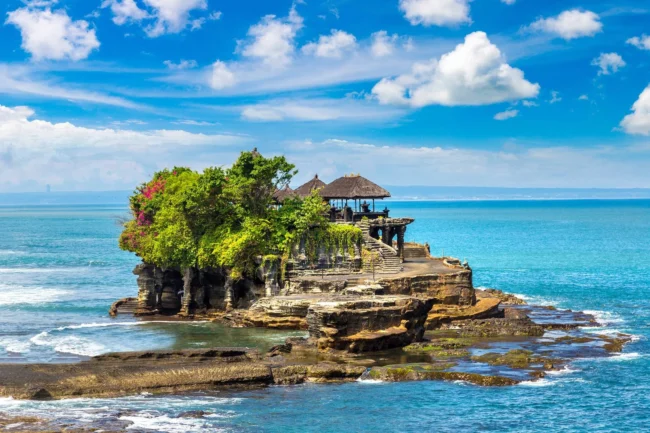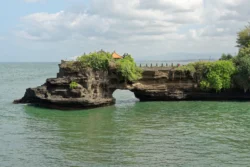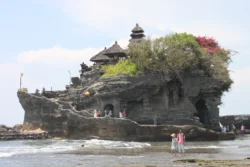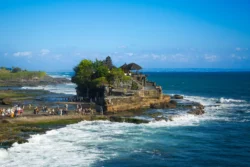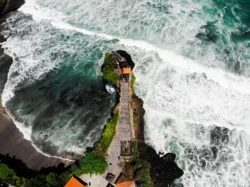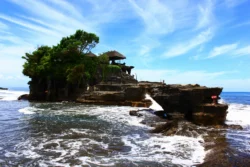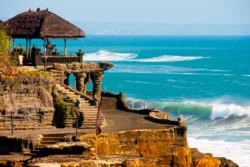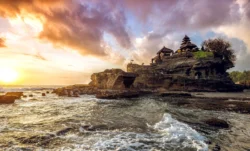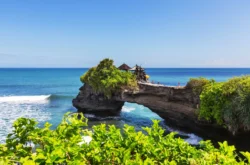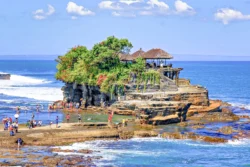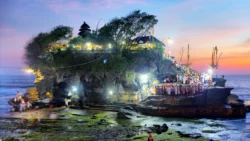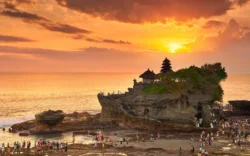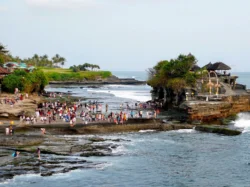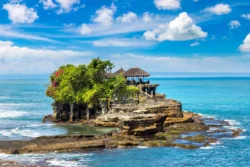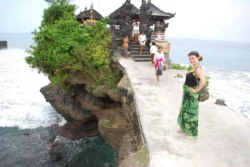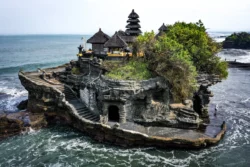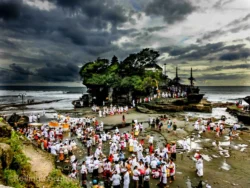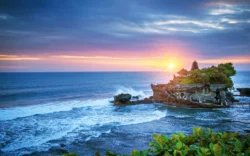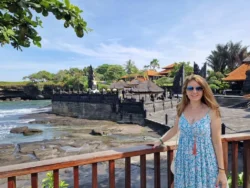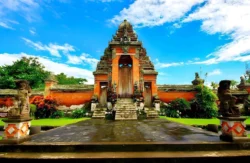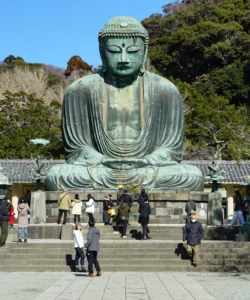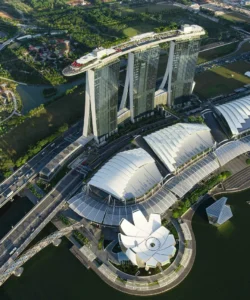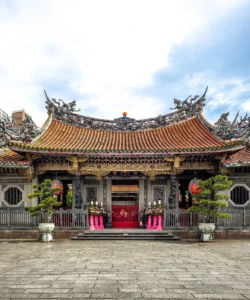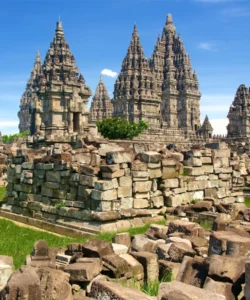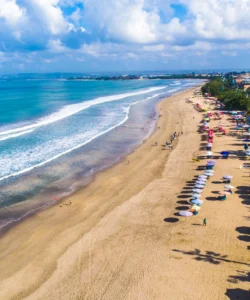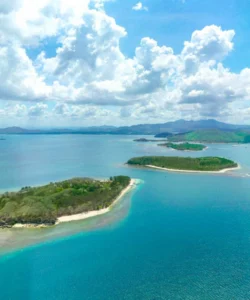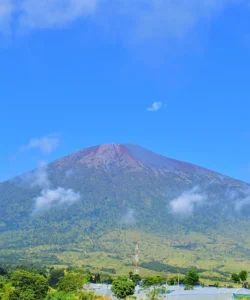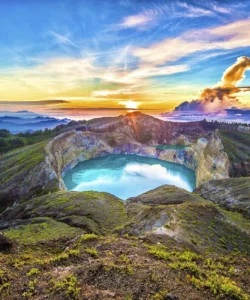Tanah Lot Temple is one of Bali’s most iconic and revered Hindu sea temples, renowned worldwide for its breathtaking offshore setting and dramatic sunset backdrops. Perched on a rocky outcrop amidst the constantly crashing waves of the Indian Ocean, it appears to float on the water during high tide, creating a mesmerizing and highly photogenic scene.
Name: Tanah Lot Temple (Balinese: Pura Tanah Lot, meaning “Land in the Sea” Temple)
Address: Beraban, Kediri, Tabanan Regency, Bali, Indonesia.
It is located on Bali’s southwestern coast, approximately 20 kilometers (12 miles) northwest of Denpasar, and about 45 minutes to an hour’s drive from popular tourist areas like Kuta, Seminyak, or Ubud.
How to Get There:
Accessing Tanah Lot Temple is straightforward, though public transport is limited:
- By Car/Scooter Rental with Driver (Recommended): This is the most convenient way to visit. You can hire a private car with a driver for a half-day or full-day tour, which offers flexibility. Scooter rental is popular for experienced riders.
- Taxi/Ride-Hailing Apps (Grab/Gojek): These services are readily available in Bali and can take you directly to Tanah Lot. For a return trip, it’s advisable to arrange with your driver or be prepared for potentially higher fares from local taxis at the site.
- Guided Tours: Many tour operators in Bali offer half-day or full-day tours that include Tanah Lot, often combined with other nearby attractions like Jatiluwih Rice Terraces or Alas Kedaton Monkey Forest. This is a hassle-free option.
- From Ngurah Rai International Airport (DPS): It’s about a 1-hour and 20-minute drive.
- Important Note: There is no direct public bus or shuttle service to Tanah Lot. Traffic can be heavy in the afternoons, especially around sunset, so planning your departure time is crucial.
- Entrance Fee: There is a mandatory entrance fee for tourists to enter the Tanah Lot complex.
Landscape and Architecture:
Tanah Lot’s “architecture” is a harmonious blend of its natural dramatic setting and traditional Balinese Hindu temple design.
- Offshore Rocky Outcrop: The temple’s most striking feature is its location on a large rocky outcrop that sits a short distance from the coastline. This rock formation has been sculpted over millennia by persistent ocean waves.
- “Floating Temple” Illusion: During high tide, the waves completely surround the base of the rock, making the temple appear to be an isolated island floating in the sea, which is a key part of its mystical allure. At low tide, a narrow pathway emerges, allowing visitors to walk closer to the base of the temple.
- Traditional Balinese Architecture: The temple itself consists of multi-tiered shrines with distinct thatched Meru roofs, typical of Balinese Hindu temples. Its stone walls are adorned with intricate carvings depicting mythological figures and traditional Balinese motifs. The design is elegant and relatively modest compared to grand temple complexes, designed to blend with its natural surroundings.
- Sea Temple Chain: Tanah Lot is part of a series of seven important Balinese “sea temples” (Pura Segara) strategically located along the island’s southwestern coast. Each temple is said to be within sight of the next, forming a spiritual chain to protect the island from evil sea spirits and the forces of the ocean. The main deity worshipped here is Dewa Baruna (Bhatara Segara), the sea god.
- Holy Sea Snakes: Legend holds that the temple is guarded by venomous sea snakes that live in the caves at the base of the rock. Visitors can sometimes see these snakes in a small cave near the temple during low tide, with local guides often sharing stories of their spiritual significance.
- Onshore Complex: The mainland clifftops surrounding the offshore temple form a larger complex with landscaped gardens, smaller shrines (like Pura Batu Bolong, another sea temple with a distinctive archway formed by erosion), visitor facilities, souvenir shops, restaurants, and cultural performance areas.
- Restoration Efforts: Due to continuous erosion from the ocean, significant restoration efforts, partly funded by the Japanese government in the 1980s, involved reinforcing the rock base with disguised artificial rock, ensuring the temple’s stability while maintaining its natural appearance.
What Makes It Famous:
- Iconic Sunset Views: Tanah Lot is globally famous for its breathtaking sunset views. As the sun descends, it casts a golden glow over the ocean, silhouetting the temple against a sky painted with vibrant hues of orange, pink, and purple, creating an unforgettable and highly photographed spectacle. It’s considered one of Bali’s best sunset spots.
- Unique Offshore Setting: The temple’s dramatic location on a rocky outcrop surrounded by crashing waves is incredibly unique and visually striking, distinguishing it from most other temples.
- Profound Spiritual Significance: It holds deep religious and cultural importance for Balinese Hindus, serving as an active pilgrimage site dedicated to the sea gods and an integral part of their spiritual practices and beliefs.
- Legend of Dang Hyang Nirartha: The temple’s origin is attributed to the 16th-century high priest Dang Hyang Nirartha, who, according to legend, created the rock formation and guardian sea snakes with his spiritual powers after facing opposition from the local chief.
- Part of the “Subak” System: While primarily a sea temple, its association with the sea gods and the prosperity of the land links it to Bali’s UNESCO-recognized “Subak” irrigation system, which emphasizes the harmonious relationship between humans, nature, and the divine in agricultural practices.
- Postcard Perfect Scenery: Its unparalleled combination of natural beauty, cultural heritage, and spiritual aura makes it one of Bali’s most photographed landmarks.
Differences from Some Other Wonders:
- Sea Temple on a Rock: The most defining difference from other wonders, even other temples in Bali like Uluwatu (cliffside) or Ulun Danu Beratan (lake temple), is its dramatic offshore location on a rock formation within the sea itself. This “land in the sea” aspect creates its unique “floating” illusion at high tide.
- Sunset as a Primary Attraction: While many sites are beautiful at sunset, Tanah Lot’s fame is almost inextricably linked to its iconic sunset spectacle, which is often the main reason tourists visit, making it a “sunset temple.”
- Focus on Sea Deities: Unlike temples dedicated to Hindu Trimurti or Buddhist cosmology (like Borobudur or Prambanan), Tanah Lot’s primary dedication is to the sea gods (Dewa Baruna) and its role in protecting the island from the ocean’s forces.
- Limited Temple Access: Unlike temples where visitors can often enter the main shrines, the interior of the main offshore temple at Tanah Lot is generally only accessible to Balinese Hindu pilgrims during specific ceremonies. Tourists view it from the surrounding cliffs and the base of the rock (at low tide).
- Blending of Natural Erosion and Man-Made Preservation: The fact that a significant portion of the temple’s rock base has been reinforced with artificial rock due to erosion, a testament to conservation challenges and efforts, adds a unique modern dimension to its ancient history.
- Absence of Extensive Relieves/Statues (compared to Borobudur/Prambanan): While it has intricate carvings, Tanah Lot is not renowned for the sheer volume or narrative complexity of bas-reliefs or hundreds of Buddha statues like Borobudur or Prambanan. Its grandeur is in its setting.
Tanah Lot Temple Photos:
